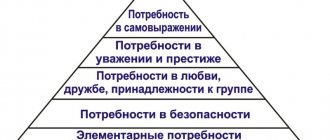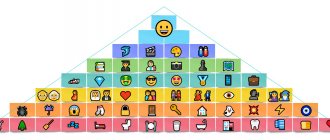The need for creativity in Maslow's system
The 7 levels of Maslow's pyramid combine the following groups of needs: Basic needs - include physiological needs, as well as safety needs, the satisfaction of which is vital for a person. Contact needs are the needs for social connections and attention from other people. Development needs are a person’s needs for development, creativity, and self-affirmation. A distinctive feature of these needs is that these needs are not satiable. The more creative a person is, the more important it is for him to engage in this activity and create more. Needs replace one another according to the principle of dominance: the highest levels of needs are updated when all previous ones are satisfied. The activity is directed towards the most unsatisfied need.
Maslow's Pyramid / >
The need for creative activity is one of the needs of the highly developed spiritual and intellectual life of people.
[p.58] Man has long sought to express his thoughts, feelings, experiences in specific tangible images and forms. The need for creativity is the highest form of expression of the human essence, abilities and talents of the individual. Unlike other needs, which are satisfied through the consumption of goods and services created by the labor of other people or nature itself, the need for creative activity is satisfied in the process of this activity itself. In this, the need for creativity is similar to the need for work, which is also realized in the process of work itself (regardless of its scope, specific focus or technical equipment). [p.58]
In our country, satisfaction of the need for creative activity and the very freedom of this activity are constitutionally guaranteed. Article 47 of the USSR Constitution states that citizens of the USSR, in accordance with the goals of communist construction, are guaranteed freedom of scientific, technical and artistic creativity. It is ensured by the widespread development of scientific research, inventive and rationalization activities, and the development of literature and art. The state creates the necessary material conditions for this, provides support to voluntary societies and creative unions, organizes the introduction of inventions and rationalization proposals into the national economy and other spheres of life. [p.58]
It must be emphasized that invention and rationalization as a form of the need for creative activity not only serve to more fully satisfy it, the comprehensive development of the spiritual powers of the individual, but also provide a huge economic effect. In the eleventh five-year plan, for example, it amounted to 36 billion rubles. (almost 2 times more than in the ninth five-year plan), and in 1986 - 8.1 billion rubles. [p.60]
Another direction in the development of needs for creative activity is art and literature. In our country there are numerous professional groups in various fields of performing arts, among which bright individuals have been brought up, whose art is recognized throughout the world. [p.61]
Along with this, amateur art is becoming more and more widespread as a form of development and satisfaction of mass needs for creative activity. At the end of 1986, there were over 700 thousand amateur art clubs, which is 1.6 times more than in 1970. In 1986, 12 million people participated in them, or almost 2 times more than in 1970 In total, 30 million people participated in all groups and amateur artistic circles (including cultural and educational institutions of trade unions in cities and collective farms) in 1986. [p.61]
The need for creative activity 58 [p.348]
Within a business, creativity should be aimed at meeting business needs and most likely manifested in team activities. She differs from the traditional stereotype of a creative individual, driven only by her personal needs for creativity and not at all focused on team achievements. Those who have high values of factors 4 and 10 will be happy to fulfill their need for creativity, enhancing the creative potential of the entire team. They will strive to make team work enjoyable. Our goal is to ensure that the team works effectively, this should be achieved by clearly defining the problem that needs to be solved and ensuring that team members clearly understand the requirements for their work. [p.87]
Those with a high drive for achievement coupled with a low need for creativity tend to achieve accomplishments while moving along a narrow, straight path. Unlike their more creative colleagues, they do not feel the need to take creative risks or look for shortcuts to solve problems. Probably, they should not be involved in those types of activities, the successful implementation of which requires subtle creative intuition. [p.145]
Management based on needs and interests is based on stimulating human activity through his needs and interests. We are talking about basic needs - food, shelter, rest, health, etc. social needs - creative work, family, order and stability, etc., as well as interests - material, social, aesthetic. This U.t. recommended for organizations in small regions (small cities, towns, etc.), where the organization’s activities directly affect the municipal infrastructure. [p.341]
Therefore, we can say that the need of workers for creative activity itself becomes an important factor in the development of Soviet art and literature. [p.61]
The web style of work allows you to better cope with the problem of unpredictability of demand. Companies often have an urgent need for certain specialists that may disappear after some time, so some areas require flexible staffing patterns to cope with such ups and downs. The Internet is allowing more companies to take an approach to managing core business components similar to that of the major Hollywood studios. Finance, marketing, distribution and other ongoing activities are handled by full-time employees, and the number of full-time employees engaged in creative work, that is, the actual creation of films, is small. After the concept of a new film passes the approval stage, the director recruits a large group of people to work on it. At the end of filming, the group disbands. Everyone, from the director and actors to the cameraman and workers, are split up on other projects. [p.144]
The designation of these rights by this term is a kind of tribute to historical tradition. With the development of technological progress and the spread of cultural values, an objective need arises for the recognition and protection of the legitimate interests of individuals who invest money and labor in the field of artistic and technical creativity and are the first to bring new ideas and samples to the attention of society. The development of legal regulation of this sphere of social activity leads to the emergence of various legal theories (theories of natural law, theories of intellectual rights). These theories in one way or another justified the recognition of rights to creative achievements directly by their creators and explained the legal nature of these rights. For these purposes they use [p.44]
Culture The goal is to implement an urban policy that forms a high level of Russian national culture for citizens, providing for the need for cultural and creative activities, with a focus on the youth of the city. [p.75]
Nikolai Alekseevich Voznesensky (1903-1950), being the chairman of the USSR State Planning Committee immediately before and during the Great Patriotic War, combined this work with creative activity. His book The Military Economy of the USSR during the Patriotic War contains extensive factual material useful for understanding the processes of economic development subordinated to the needs of war. The primary statistical material for this work has not yet been made public. [p.155]
Students who prefer a project-based learning style are distinguished by their initiative in relation to the learning situation as a whole. This applies to both the content of the educational material and the learning process. For this category of students, learning is a process that never stops and is best implemented in real activities. They are ready to get involved in various projects, participate in activities in a variety of positions (from performing to creative). They tend to turn a lecture session into a discussion, and fill a business game with many significant nuances. They need to understand as widely and deeply as possible the complex and varied activities for which they are preparing themselves and which, in their opinion, cannot be unambiguously defined in the form of instructions. In addition, students with a project-based learning style are characterized by the need for a personal choice of professional positions and roles, as well as areas that they consider priority and important from the point of view of their own development. Orientation to a project-based learning style can be especially effective in training senior managers, consultants and, of course, teachers. [p.371]
Consideration of the standard of living of the population, based on the degree of satisfaction of needs, allows us to more fully present its characteristics. In this understanding, the standard of living of the population will ultimately be determined based on the satisfaction of the highest need in the hierarchy for self-realization and self-development. Thus, the standard of living will depend on the extent to which conditions for creative activity have been created in society, primarily in science and art. Naturally, basic needs underlie social development; without them it is unthinkable. But at the same time, it is the need for self-realization and self-development that ensures social development; it has made man truly human. [p.493]
There are many definitions of the concept “need”. In them, the main thing, as a rule, is a sign of a lack of something, that is, the concept of need is usually defined through the concept of need. We believe that the concept of need should also include the desire for something, for example, fame, power, creative activity, spiritual perfection. Thus, the above definition can be considered more general than the existing ones. [p.10]
Secondly, Maslow’s books and articles emphasize the relativity of the hierarchy of needs, its dependence on the individuality of people, the goals that they consider basic for themselves. There is no pyramid of needs in any of Maslow's publications. And it’s not just the lack of appropriate drawings. From the meaning of the texts of the founder of humanistic psychology it follows that there cannot be a rigid, uniform hierarchy of needs for everyone. Maslow emphasizes the particular importance of individualizing the structure of needs for those who strive for creative activity. [p.58]
A person’s participation in economic activity is characterized by his needs and the ability to satisfy them, which are determined primarily by the characteristics of labor potential: health, morality, creativity, activity, education, professionalism, organization, and working time resources. Thus, a person in a market economy acts, on the one hand, as a consumer of goods produced by enterprises, and on the other, as the owner of the abilities, knowledge and skills necessary for enterprises, government and public bodies. [p.265]
Our research shows that for individuals with a high need for creativity, monetary reward is usually of little importance as a motivator. If they are hired, they must be given the opportunity and space to be creative in their own way. This means that they need the opportunity to devote themselves to what interests them. It follows that if they do have this quality, then they are hired to work at a university or research institute where the vast majority of the work requires creativity, say, in the field of research or the implementation of large projects. If they do not have outstanding abilities, then the cost of their wages is recouped by using that part of their creativity that has commercial application, or other areas of their work that are not related to creativity. But if you don't give them space for creative activity, they may leave the organization, putting themselves in a financial situation that less creative and creative individuals would call financial ruin. [p.192]
The modern world market is characterized by a constant expansion of commodity circulation due to the deepening of the international division of labor, the development of science and technology, and the growth of social and personal needs. The circle of T. involves increasingly diverse results of labor activity, including not only products in embodied form, but also the fruits of creative intellectual activity in the form of technical documentation, scientific publications, works of literature and art, as well as [p.410]
However, the answer to the question of what costs are necessary remains outside the scope of the definition. For example, there are known difficulties in attributing to free time the costs of fulfilling social duties or realizing the need for social activity. On the one hand, we see the voluntary nature of human participation in the activities of party and public organizations, the creative nature of raising children, communicating with family [p.225]
Intellectual needs are born by the human mind and are associated with his intellectual activity. These are the needs for knowledge of the surrounding world, education, advanced training, various types of creative activities (including amateur creative activities), etc. [p.24]
Each person will voluntarily and consciously participate in production activities, in the creation of those benefits that are necessary for his life and for the well-being of society. All members of society, thanks to the change in the nature of work and the growth of its technical equipment, thanks to a high level of consciousness, will develop an internal need to work voluntarily and according to their inclinations for the public good. People will not be able to live without participating in creative, constructive work, just as they cannot live without air. Working according to your abilities will become a habit, the first vital need of a person. [p.406]
Moral incentives to work are factors that encourage members of society to engage in socially useful activities to realize their needs for work and achieve social goals (outside of the corresponding appropriation of life benefits). The moral stimulus of labor is, first of all, labor itself as a special form of human life; the creative, productive nature of labor generates satisfaction with the achieved result and labor competitiveness. These are creative incentives for work. The actual moral incentives are conscious social and collective goals and objectives, as well as personal prestige associated with the acquisition of a certain professional and social position. [p.222]
Increasing the creative nature of workers’ work is one of the most important functions of engineering and technical personnel. From the very beginning of the formation of a new type of brigade, an objective need arose to satisfy the demands of workers in creative work that was richer in content. This need can be fully realized only with the help of the technical intelligentsia. The transfer of new ideas by engineering and technical workers, joint search and implementation activities with working teams are carried out in different forms. [p.206]
Moral incentives are factors that encourage people to engage in socially useful activities to realize their need for work and its results. in achieving certain social goals. M. s. include various types of public recognition and rewards for achieved high results in the work activities of employees and teams and are aimed at maintaining and developing the labor initiative and creative activity of workers. [p.142]
Unlike the time of the so-called “Red Project”. See Belousov A.R. Formation of the Soviet industrial system // Russia XXI. - 2000. - No. 1. - P. 31. The arguments of A.V. are of interest here and may cause possible controversy. Buzgalin about the simultaneous formation of both material, material needs and “needs for creative activity” in the process of formation of our neo-economics sector. See Formation of the Russian model of a market economy, contradictions and prospects Int. scientific conf. “Lomonosov Readings” April 24-26, 2002 Materials for discussion / Rep. per issue K.A. Khubiev. - M. MAX Press, 2002. - P. 25-33. [p.120]
NEEDS - the need for something necessary to maintain the life of an organism, a person, a social entity. groups, society as a whole, an internal stimulator of activity. There are biol. Human P. caused by metabolism, a necessary prerequisite for the existence of any organism, and social P. subjects (individuals, social groups) and society as a whole, which are formed depending on the level of development of a given society and specific social. conditions of their activities. The source of development of the latter is the relationship between the production and consumption of material and spiritual goods. Satisfaction with relatively elementary, vital P. leads to the generation of new P. and this distinguishes man as a subject of his own historical process, transforming natural and social. environment, from an animal adapting to its environment. The personalities form a sort of hierarchy, at the base of which are the vital traits, and its subsequent levels are social. P., the highest manifestation of which is P. in self-realization, self-affirmation, i.e. in creative activity. When studying human P., the following types are distinguished by spheres of activity: P. labor, cognition, communication, recreation according to the object; P. material and spiritual, ethical, aesthetic, etc. according to their functional role - P. dominant and secondary, central and peripheral, stable and situational according to the subject - P. group, individual, collective, public. [p.265]
GOODS (goods, ommodity) is an economic category, which in its most general form can be defined as a product sold on the market, an object of purchase and sale. The modern world economy is characterized by a constant expansion of commodity circulation in connection with the development of science, technology, and the growth of social and personal needs. The number of goods includes increasingly diverse results of human activity, including not only products in material form, but also the fruits of creative and intellectual activity in the form of technical documentation, scientific publications, works of literature and art, as well as a variety of services and works. At the same time, new, rare T. are usually sold at high prices. The development of mass production is accompanied by a decrease in prices. The most expensive technologies are science-intensive, artistic, and other products that require a lot of mental effort. With the increasing inclusion of natural resources into economic circulation, many of them also acquire the properties of a commodity, becoming an object of purchase and sale with a steady tendency to increase prices for them (land, minerals, wild animals and plants, water, etc.). In foreign trade transactions, it is recommended to accurately and in detail indicate the name of the product that is the object of purchase and sale. [p.226]
Culture of cooperation Open organizational systems. Democratic management form. Participative organizational culture. Forms of organization of joint creative activity predominate. The area of goal determination is the legitimate interests of the majority of the people, with mandatory consideration of the interests of the minority. The type of management is a developing economy, focused on the use of renewable resources, primarily human ones. Equity (cooperative, joint stock) forms of ownership. The power mechanism is the separation of powers (a system of shifts and balances); the main function is to regulate various aspects of social life. The economic mechanism is distribution according to contribution (labor, capital) and redistribution according to socially recognized needs. The main ethical value is the equality of all before the law. The basic moral and psychological principle is humanism. [p.21]
For individuals prone to creative activity, the problem of free time practically does not exist. The creative process itself and its results constitute for them the most desirable good (pleasure), the usefulness of which does not decrease with consumption (within the limits of physical capabilities). Unlike the consumption of material goods, creative activity does not obey the laws of Gossen and Weber-Fechner. These laws also do not apply to the needs for spiritual improvement and most social needs. It is known that there is no such thing as too much fame and power. In particular, a person striving for power experiences constant dissatisfaction with this specific good and seeks “opportunities to expand his sphere of influence. The examples of Stalin and Hitler are especially impressive. [p.70]
NEEDS is one of the fundamental categories of theoretical and applied economics. These are the types of products, goods, services, things, creative activities that people need, that they desire, strive to have and consume, and use the internal stimulator of activity. Needs include not only what benefits people and is essential for life, but also real requests for items that may be harmful to health, but are consumed by people due to established habits and the pleasure and satisfaction they receive. Needs are divided into biological and social, the latter are determined by the social nature of a person. In addition, they are distinguished. satiable and unsatisfiable needs. The unsatisfied include, for example, the need for knowledge, spiritual food, and sometimes the need for money, which is always in short supply. [p.253]
Creativity can be a clear source of recognition. Those who are driven by a high need for recognition and are successful in expressing creativity will find themselves in ideal conditions. They will be self-motivated to a large extent. Their need for recognition will also help them focus their attention on those from whom they expect recognition. In some cases, this can create a problem - they will try to generate ideas to please those from whom they expect recognition, but these ideas may not actually satisfy the needs of the business. In this situation, the need for recognition will begin to limit their creative independence. They will also suffer when the ideas they thought would bring them recognition do not live up to their expectations. Then their creative energy will be spent on gaining recognition, and not on creative activity. [p.123]
Behavior management is a type of creative activity. In Fig. Figure 2.1 shows the structure of motives for human creative activity (the symbol (B) means the interaction of Providence - a set of events that realize the Creator’s plan), the driving force of which is the emerging vital need (Pt), felt by him as a feeling of discomfort, which in turn gives rise to desire (and not always accessible to expression) - the desire to eliminate this feeling. An expressible desire is very important in the technical aspect due to its constructiveness - after all, this is a person’s representation of a method (expressed in the language of phenomena known to him), which, in his opinion, will eliminate the feeling of discomfort; only on its basis can one form a system that fulfills the desire, which is the system management. From Fig. 2.1, the reason and degree of necessity for creating a control system becomes clear, as well as the main paradox of management: the task of management is to satisfy a desire, while the driving motive for management is a need that causes a feeling of discomfort. [p.199]
It is necessary, however, to distinguish between the concepts of labor as the first vital need and the need for labor. If the transformation of labor itself into the first vital need of a person must be prepared by the development of productive forces and production relations, then the need for labor as a social need for meaningful, creative work activity, appropriately paid, really exists among members of a socialist society and requires its satisfaction. Now this need, as noted at the XXVII Congress of the CPSU, is increasingly coming to the fore 4. [p.37]
We fully agree with economists who believe that a single fund for the development of science and technology should be distributed in the process of financing work in proportion to the economically justified optimal costs necessary to implement each stage of technical progress, taking into account the achievement of maximum efficiency per unit of cost at each stage, and in relation to the development of the entire fund as a whole. But, as B. D. Motorygin and P. A. Sedlov quite rightly note, ... accurate accounting of the need for funds is practically impossible due to the lack of possibility of establishing accurate standards for the costs of research, development and development of new technology and the presence of uncertainty in the field of creative activity costs and results of labor 2. [p.46]
see also
- the meaning of creativity,
- creativity is a central element of human existence,
- types of creativity,
- creativity, theories of creativity,
- phenomenology of creativity,
- assisted creativity, use of assistive systems for creativity,
- development of children's creativity, stages of development of visual creativity,
Do you enjoy the need for creativity? or do you have any useful tips and additions? Write to other readers below. I hope that now you understand what the need for creativity is and why all this is needed, and if you don’t understand, or if you have any comments, then don’t hesitate to write or ask in the comments, I will be happy to answer. In order to gain a deeper understanding, I strongly recommend studying all the information from the category Psychology of Creativity and Genius
Types of human needs
Needs can be divided into two types: innate and acquired.
Innate are those with which a person came into this world. The baby cannot do without food, water, air. He needs to feel that his mother is nearby and takes care of him. It is necessary that the room is warm, otherwise it will freeze. Even an adult cannot live without basic needs. He also needs to eat, sleep, and breathe.
Acquired are those that appeared as a result of interaction with the social environment. For example, they will be different if a person grew up in a poor and rich family. Some will be happy if they are given sausage sandwiches for breakfast instead of oatmeal, while others will be offended if they are given a two-room apartment instead of a townhouse. If suddenly the realities of life change, and a person accustomed to luxury is left without the usual big money, then he will experience severe discomfort, even if he has the opportunity to satisfy basic needs.
When does Maslow's pyramid not work?
In general, these 5 Maslow levels may not always work. The theory is valid if you look at humanity in a generalized, theoretical way, without taking into account the many special cases when it does not work. The pyramid usually does not work in the following cases:
- We are dealing with an extraordinary person. If we meet an unusual person who has some kind of spiritual filling above the usual, then such a person may neglect many things for the sake of the higher, say, earn less in order to have more time to engage in art;
- The opposite case is that some people cannot rise above the basic levels, although they are fully satisfied. Instead of simple food, they look for gourmet food, instead of a resort in their own country, they work and collect money for a trip to Thailand, instead of self-realization in the family, they endlessly change lovers for the sake of imaginary respect and envy of others, etc.
We can say that deviations in Maslow’s theory work most clearly on people outside the average type: geniuses and various deviants.
Personality culture
Aesthetic consciousness is part of social consciousness, its structural element. It, together with morality, forms the basis of modern society, helps humanity to develop, and has a positive effect on people’s spirituality. In its activity, it manifests itself in the form of a spiritual need, expressing an attitude towards external factors. It is not opposed to aesthetic development, but stimulates a person to be active and helps him put theoretical knowledge into practice.
Satisfying Spiritual Needs
Spiritual needs begin to form already in childhood . During this period, events are perceived more vividly and colorfully by the child’s consciousness. That is why it is especially important for parents to instill aesthetic and spiritual qualities from an early age.
Thanks to the development of spiritual qualities, the child not only develops spiritually, but also learns to interact positively with the world around him.
In adolescence, it will be much easier for him to survive the crisis and establish the correct moral principles. Spiritual development gives the individual strength to overcome difficulties and adversity. You can satisfy your spiritual needs in various ways:
- Communicate with nature. For some, going to the dacha is perceived as torture that does not bring satisfaction. Try to take a break from the bustle of the city and go into nature, relax and admire the sunset, breathe in the clean forest air, and walk along well-trodden paths.
- Plunge into the world of art. Determine for yourself a direction that interests you and try to study it from different angles. To satisfy your spiritual needs, visit the theater, a concert of your favorite band, go to a gallery or go to the movies.
- Listen to yourself. By listening to your inner voice you can get a lot of useful information. Find time to dialogue with yourself, plunge into your own thoughts. Try to answer the question: “What do I want?”
- Spend time with animals. Communication with living nature can lift your spirits and charge you with positive emotions.
Even in satisfying simple needs there may be a hidden path to harmony and peace of mind. Satisfying spiritual needs will help you discover your personal potential, distract you from everyday life, and help you cope with stress.
Other classifications of human needs
It is interesting that throughout human history, philosophers and scientists have put forward different classifications of needs .
So the ancient Greek philosopher Epicurus divides them into three types:
- Needs without which it is impossible to live, calling them natural and obligatory .
- Needs are natural, but optional . For example, if a family of five is huddled in a one-room apartment, it has a need to expand its housing, but in essence it is able to survive in such conditions.
- Needs are unnatural and optional . In this case, whims that are not natural can be considered. For example, “I want to live in the forest, away from everyone,” “I want a horse to become my husband,” etc.
Another interesting classification of needs belongs to psychoanalyst Erich Fromm.
- He put love and friendship , regarding them as the main ones that a person needs.
- In second place is self-affirmation and a sense of self-worth .
- The third is the need to belong to any social group, religion, or culture.
- Fourth place according to Fromm is occupied by creativity and a person’s desire to create something .
- And finally, fifth - knowledge of the world that surrounds a person.











